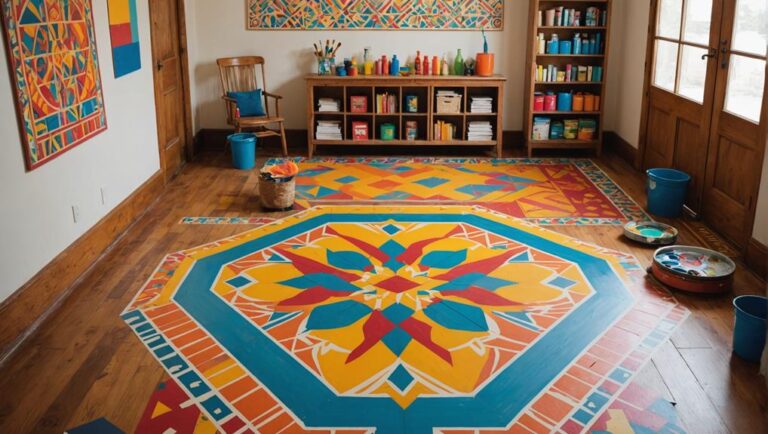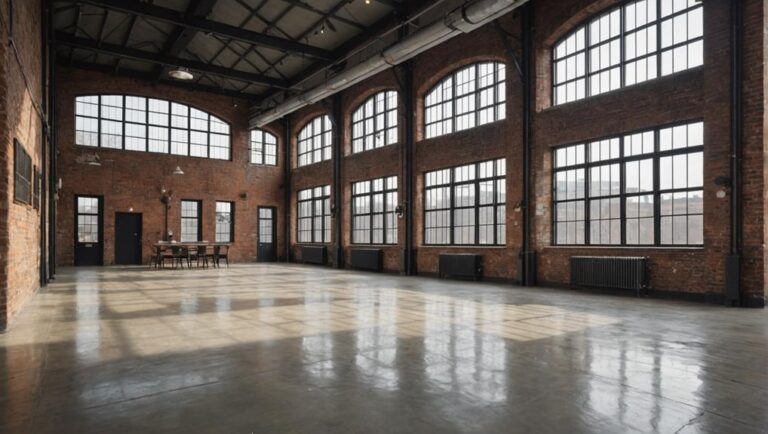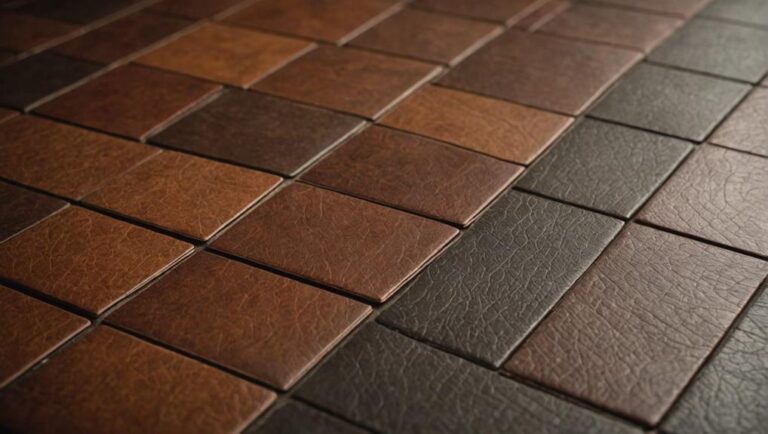To restore vintage tile floors, start by evaluating their condition, noting any cracks, chips, or discoloration. Gather essential supplies like a soft-bristled brush, microfiber mop, and pH-neutral cleaners. Begin cleaning by sweeping and using a diluted cleaner, rinsing thoroughly. Repair damaged areas with color-matching filler or by replacing broken tiles. Check and regrout as necessary, ensuring color matches. Apply an appropriate sealer once the grout cures. Finally, polish the tiles using a soft cloth for shine. Consistent maintenance will enhance their longevity and appearance, and you'll find further details on each step as you proceed.
Assessing the Condition
Before diving into the restoration process, you need to assess the condition of your vintage tile floors. Start by examining the tiles closely for any visible damage, such as cracks, chips, or discoloration. Document each issue, as this will inform your restoration strategy. Pay particular attention to the grout lines, as deteriorated grout can compromise the integrity of the tiles and lead to further damage.
Next, evaluate the overall structural condition of the floor. Check for signs of unevenness or sagging, which may indicate underlying issues with the subfloor. This is essential, as a sound subfloor is important for the longevity of your vintage tile. If you notice any soft spots, it's imperative to investigate further, as they could signal water damage or pest infestations.
Additionally, consider the tile's history. Understanding the floor history can provide insight into its material composition and previous maintenance methods. This knowledge is invaluable when selecting appropriate restoration techniques and products. If your tiles are made of natural materials like terracotta or marble, they may require specialized care to prevent damage during the restoration process.
Gathering Necessary Supplies
Before starting your restoration project, you need to gather essential supplies to guarantee a successful outcome. This includes selecting the right cleaning tools, appropriate cleaning solutions, and necessary protective gear. By preparing these items in advance, you'll streamline the restoration process and protect both yourself and the vintage tiles.
Essential Cleaning Tools
To effectively restore vintage tile floors, having the right cleaning tools at your disposal is vital. Using the appropriate tools not only helps protect the vintage materials but also guarantees that your cleaning methods are efficient and effective. Here's a list of essential cleaning tools you'll need:
- Soft-Bristled Brush: A gentle brush is important for removing dirt and grime without scratching the tile surface. Choose one that's specifically designed for delicate materials.
- Microfiber Mop: This mop is ideal for collecting dust and debris. It's safe for vintage tiles and won't leave behind scratches.
- Bucket: A sturdy bucket is necessary for mixing your cleaning solutions and rinsing the mop. Make sure it's large enough to hold ample water to avoid constant refilling.
- Protective Gloves: Always wear gloves to protect your skin from any cleaning agents. They also provide a better grip, promoting safer handling of tools.
Equipping yourself with these essential cleaning tools will set a solid foundation for restoring your vintage tile floors. Prioritize safety and care to maintain the integrity of your unique flooring.
Recommended Cleaning Solutions
Restoring vintage tile floors requires careful consideration of the cleaning solutions you choose, as the right products can enhance the beauty of your tiles while guaranteeing their longevity. Start by evaluating eco-friendly options that are safe for both your tiles and the environment. Look for pH-neutral cleaners specifically designed for tile, as they won't damage the surface or grout.
You might also consider homemade solutions, which can be effective and less harsh. A simple mix of warm water and white vinegar can help lift dirt and grime without leaving harmful residues. Alternatively, a baking soda paste, mixed with water, can tackle stubborn stains without scratching the tile.
As you gather your supplies, guarantee you have a gentle scrubbing brush or microfiber cloth to apply these solutions. Avoid abrasive materials that could harm your vintage tiles. Always test your chosen cleaner on a small, inconspicuous area first to ensure compatibility. This methodical approach not only promotes safety but also maximizes the effectiveness of your cleaning efforts, preserving the integrity of your vintage floors for years to come.
Protective Gear Needed
Gathering the right protective gear is essential when restoring vintage tile floors. Safety precautions are important in ensuring your well-being during this process, as you're likely to encounter dust, chemicals, and sharp tools. By using suitable materials, you can effectively safeguard yourself.
Here's a list of protective gear you should gather before starting your project:
- Safety Goggles: Protect your eyes from dust and chemical splashes that may occur during cleaning and restoration.
- Dust Mask or Respirator: This is critical for filtering out harmful particles and fumes, especially when you're working with abrasive materials or cleaning solutions.
- Heavy-Duty Gloves: Use chemical-resistant gloves to shield your hands from harsh cleaners and potential cuts from broken tiles.
- Knee Pads: If you'll be kneeling for extended periods, knee pads can help prevent discomfort and injury, allowing you to work effectively.
Cleaning the Tiles
Cleaning the tiles is a essential step in restoring vintage tile floors, as it not only enhances their appearance but also prepares them for further restoration processes. To begin, identify the tile types present in your space, such as ceramic, porcelain, or natural stone, since each requires specific cleaning methods. Gather your materials, including a pH-neutral cleaner, soft-bristle brush, mop, and bucket.
Before you start, make certain your workspace is free from debris. Sweep or vacuum the floor to remove loose dirt and dust. For regular cleaning, aim for a frequency that suits your environment—monthly for low-traffic areas, and weekly for high-traffic zones. This practice prevents grime build-up and prolongs the life of your tiles.
To clean the tiles, dilute the pH-neutral cleaner in warm water according to the manufacturer's instructions. Test the solution on a small, inconspicuous area to verify it won't damage the tile or grout. Once confirmed, apply the solution using a mop or soft-bristle brush, working in sections. Avoid excessive scrubbing, especially on delicate tiles, which could cause scratches.
After cleaning, rinse the area thoroughly with clean water to remove any residue from the cleaning solution. This step is essential, as leftover cleaner can attract dirt and create a dull finish. Finally, allow the tiles to air dry completely. By following these steps diligently, you'll maintain the beauty and integrity of your vintage tile floors for years to come.
Repairing Damaged Areas
How can you effectively address damaged areas in your vintage tile floors? Repairing these areas is vital for maintaining the integrity and appearance of your flooring. Here's a methodical approach to tackle cracks and damage.
- Assess the Damage: Begin by carefully examining the affected tiles. Identify whether the issue is a minor crack or a more significant break that may require tile replacement.
- Crack Filling: For small cracks, use an appropriate crack filler. Select a filler that matches the color of your tile. Clean the area thoroughly, then apply the crack filler according to the manufacturer's instructions. Smooth it over the crack using a putty knife, making sure it's level with the surrounding surface.
- Tile Replacement: If the damage is extensive, you'll need to replace the tile. Start by removing the damaged tile with a chisel and hammer, taking care not to damage adjacent tiles. Clean the area and prepare it for the new tile. Apply adhesive evenly and press the new tile into place. Confirm it's aligned with the surrounding tiles.
- Curing Time: Allow adequate time for the crack filler or adhesive to cure as per the product guidelines. This step is essential to guarantee the durability of your repairs.
Regrouting and Sealing
To effectively restore your vintage tile floors, you need to start by evaluating the condition of the existing grout. Once you've identified any issues, selecting the appropriate grout is essential for ensuring durability and aesthetic consistency. Finally, understanding various sealing techniques will help protect your newly regrouted tiles from moisture and staining.
Assessing Grout Condition
Evaluating the condition of grout is essential for ensuring the longevity and appearance of your vintage tile floors. Grout can suffer from various issues, including discoloration, which can arise from dirt accumulation, moisture, or mold. Identifying grout discoloration causes is the first step in determining the necessary grout repair techniques.
Here's how to assess your grout condition effectively:
- Visual Inspection: Look for cracks, chips, or missing sections in the grout. Discoloration often indicates underlying problems.
- Moisture Test: Apply a few drops of water to the grout. If it absorbs quickly, the grout may have lost its sealing properties.
- Touch Test: Gently press the grout with your fingertip. If it crumbles or feels soft, it's a sign of deterioration.
- Mold Presence: Check for any dark spots or odors. Mold growth not only affects appearance but can also pose health risks.
Once you've assessed the condition, you can move forward with appropriate regrouting and sealing to restore your floors. Always prioritize safety by wearing gloves and a mask when handling cleaning chemicals.
Choosing the Right Grout
After evaluating your grout condition, the next step involves selecting the appropriate grout for regrouting and sealing. It's vital to take into account various grout types, as they greatly influence both durability and aesthetic appeal. The primary grout types include sanded, unsanded, and epoxy. Sanded grout is ideal for wider joints, while unsanded is better for tight spaces. Epoxy grout offers superior resistance to stains and moisture, making it a safe choice for high-traffic areas.
When choosing grout, color matching is essential to maintain the vintage look of your tile floor. You may want to take a sample of your existing grout to a local supplier for accurate color matching. This guarantees that the new grout blends seamlessly with your tiles, preserving their historical integrity. Additionally, think about the finish of the grout. A matte finish tends to be more traditional, while a glossy finish can modernize the look.
Sealing Techniques Explained
Sealing your vintage tile floors is an essential step in preserving their beauty and extending their lifespan. Proper sealing protects against moisture, stains, and wear while enhancing the overall appearance. Here are some effective sealing methods and application techniques to take into account:
- Choose the Right Sealer: Select a penetrating sealer for natural stone tiles or an acrylic-based sealer for ceramic tiles. Each type offers unique protective qualities.
- Prepare the Surface: Verify the tiles are clean and dry before applying any sealant. Remove old grout, dirt, and debris to promote better adhesion.
- Apply the Sealer: Use a paintbrush or roller to apply the sealer evenly across the tiles. For grout lines, a small brush can help guarantee thorough coverage.
- Allow to Cure: After application, let the sealer cure according to the manufacturer's instructions. This step is critical for achieving ideal protection and durability.
Polishing for Shine
Once you've cleaned your vintage tile floors thoroughly, the next step involves polishing for shine, which can greatly enhance their appearance. Polishing not only restores the luster but also protects the surface from future damage. You'll want to choose appropriate polishing techniques based on the type of tile you have.
Start by selecting a high-quality polish designed for vintage tiles. Apply it evenly using a soft cloth or a floor buffer, guaranteeing you cover all areas without leaving streaks. For best results, follow the manufacturer's instructions regarding application and drying times.
Here's a quick reference table for common polishing techniques:
| Polishing Technique | Description |
|---|---|
| Dry Buffing | Uses a buffer with a soft pad to create shine without moisture. |
| Wet Polishing | Involves applying a liquid polish and gently buffing with a damp cloth. |
| Wax Application | Adds a protective layer that enhances shine and durability. |
Always guarantee proper ventilation when working with polishes and consider wearing gloves to protect your hands. After polishing, allow the floor to dry completely before walking on it to avoid slipping or damaging the finish.
Regularly polishing your vintage tile floors can enhance the shine and extend their life, so make this a part of your restoration routine. By adhering to these techniques, you'll enjoy a beautiful, gleaming floor that reflects the charm of its vintage character.
Maintaining Your Restored Floor
To keep your restored vintage tile floors looking their best over time, establishing a consistent maintenance routine is crucial. Proper floor maintenance guarantees the longevity of your tiles and enhances their aesthetic appeal. Follow these guidelines to guarantee effective tile preservation:
- Regular Cleaning: Sweep or vacuum your floors daily to remove dirt and debris. Use a damp mop with a pH-neutral cleaner specifically designed for tile surfaces. Avoid abrasive cleaners that can dull the finish.
- Immediate Spill Management: Promptly clean up spills using a soft cloth to prevent staining. Avoid using harsh chemicals, which can damage the tile's surface and grout.
- Periodic Sealing: Depending on the type of tile and grout, reseal every 1-3 years to protect against moisture and stains. Guarantee the surface is clean and dry before applying a high-quality sealant.
- Temperature and Humidity Control: Maintain a stable indoor environment. Excessive heat and humidity can affect the integrity of the tiles and grout, leading to cracks or mold growth.
Frequently Asked Questions
Can I Use Regular Cleaning Products on Vintage Tile Floors?
You shouldn't use regular cleaning products on your vintage tile floors. Many common cleaning solutions contain harsh chemicals that can cause tile damage, fading, or discoloration. Instead, opt for pH-neutral cleaners specifically designed for delicate surfaces. Always test any product on a small area first to guarantee compatibility. Regular maintenance with the right products will help preserve the integrity and beauty of your vintage tiles, keeping them looking their best for years to come.
How Much Time Does the Restoration Process Typically Take?
When considering restoration techniques, it's essential to understand the time estimates involved. Typically, the process can take anywhere from a few days to several weeks, depending on the extent of damage and the techniques used. You'll want to factor in the time for cleaning, repairing, and sealing the tiles. Ensuring safety during this time is important, so plan adequately to avoid rushing through any critical steps in the restoration process.
Are Vintage Tiles Safe for Homes With Pets or Children?
When considering vintage tiles for homes with pets or children, it's essential to assess their safety. Most vintage tiles are made from natural materials, which generally don't pose hazards. However, you should guarantee there are no sharp edges or loose tiles that could cause injury. Additionally, check for any harmful chemicals in the adhesives or sealants used. Regular maintenance will help maintain both pet safety and child safety, securing a safe environment for everyone.
What Types of Vintage Tiles Are Most Commonly Restored?
Did you know that around 20% of homes built before the 1960s feature vintage tile? When restoring these tiles, you'll often encounter materials like ceramic, porcelain, and terracotta. Restoration techniques include cleaning, repairing cracks, and re-grouting, ensuring a safe environment for families. Each tile's specific material dictates the approach, emphasizing the need for careful handling. Always prioritize safety during restoration to maintain a healthy space for both kids and pets.
Is It Possible to Restore Tiles Without Professional Help?
Yes, you can restore tiles without professional help through DIY restoration techniques. Begin by evaluating the tiles' condition and cleaning them with a gentle pH-neutral cleaner. For minor cracks or chips, use a suitable epoxy filler. Guarantee proper ventilation and wear safety gear during the process. Regular tile maintenance, like sealing and avoiding harsh chemicals, can prolong the life of your restoration. Just remember to take your time and follow safety protocols.




